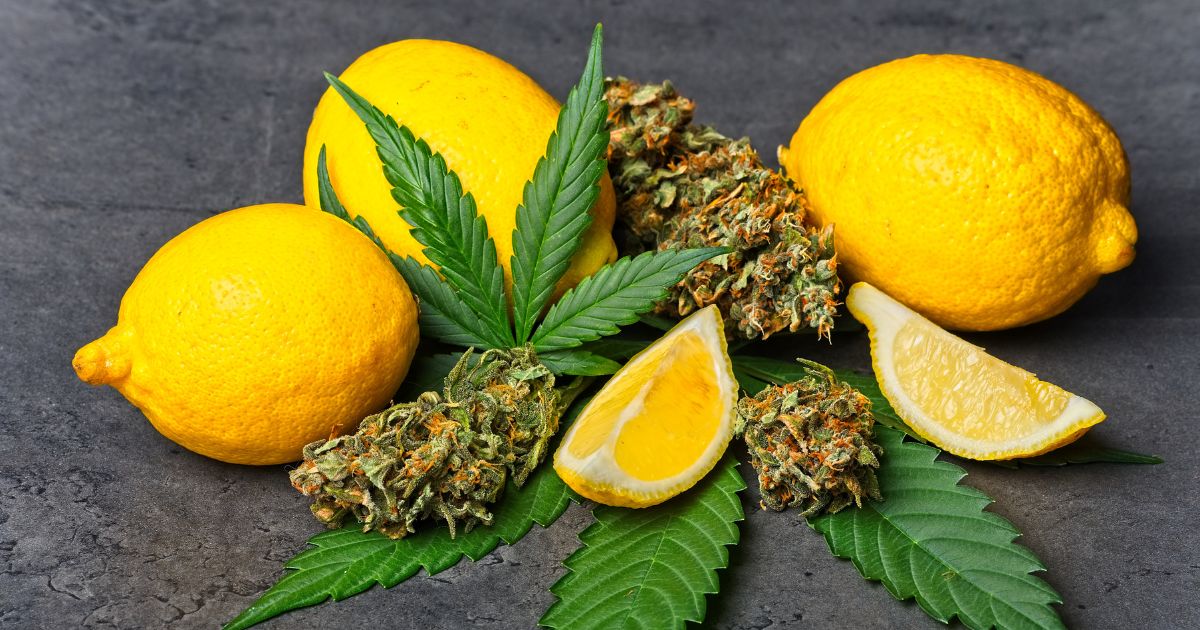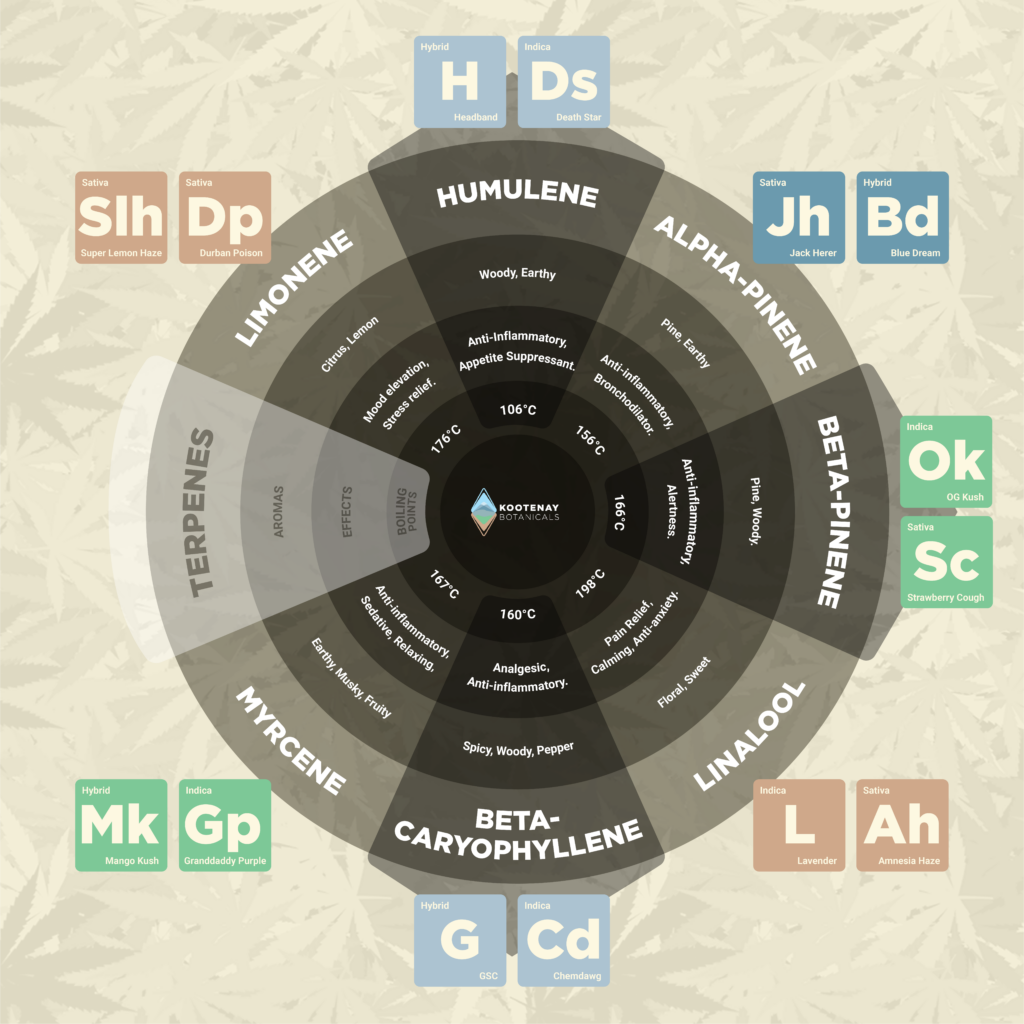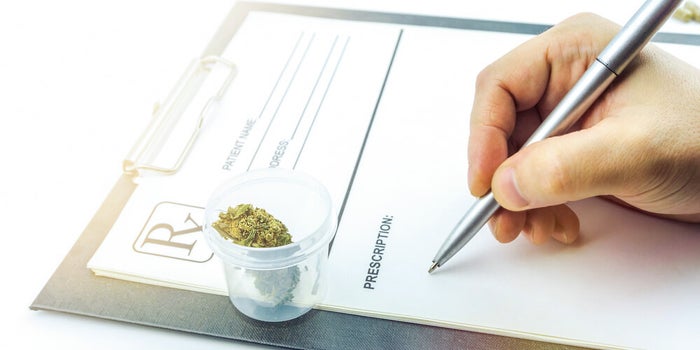Table of Contents
- What Are Cannabis Terpenes?
- What Do Cannabis Terpenes Do?
- Do Cannabis Terpenes Get You High?
- How Do They Compare to THC & CBD?
- Common Terpenes
- Terpene Chart
- Conclusion
Have you ever wondered why certain cannabis strains smell fruity while others have a more herbal scent? Why do some offer a calming effect and others induce energy? The answer lies in the terpenes! Cannabis terpenes are fragrant, aromatic oils secreted by the same glands that produce cannabinoids like CBD and THC. Not only do they give cannabis its unique flavour profile, but they also interact with other compounds to create an entourage effect.
In this blog, you’ll learn about the power of cannabis terpene effects, explore how these aromatic compounds shape your cannabis experience, and uncover the subtle interplay between scent and sensation.
What Are Cannabis Terpenes?
Cannabis terpenes are aromatic compounds that give marijuana its unique scent and flavour. These organic molecules are found in the resin glands of cannabis flowers, leaves, and stems. Terpenes play a vital role in differentiating various strains of marijuana based on their distinct aroma profiles. Their effects vary depending on the specific compound present in a particular strain of cannabis.
Limonene is one such terpene with uplifting effects commonly associated with citrus fruits. Meanwhile, myrcene has sedative properties often attributed to hops used in beer-making. Lastly, pinene is known for its energizing effects and is also found in pine trees.
Understanding the role that different terpenes play can help you choose strains that align with your desired effects or preferences. As more research continues into the complex interactions between cannabinoids and terpenes, it’s likely we’ll gain even greater insight into how these compounds affect our bodies and minds.
But first, let’s explore what exactly cannabis terpenes do.
What Do Cannabis Terpenes Do?
Well, beyond just smelling good (and potentially masking the strong odour of THC), terpenes also have various effects on the body and mind when consumed alongside cannabinoids like CBD and THC.
Cannabis terpenes are powerful compounds that provide therapeutic and medicinal benefits. They have sedating effects as well as unique aromas like earthy, floral, or fruity notes. Here’s a list of what cannabis terpenes can do:
- Fight inflammation in the body.
- Enhance cannabinoids’ effects on the brain.
- Create an entourage effect with other plant molecules.
- Provide calming and relaxing effects.
Terpenes interact with cannabinoids to create feelings of relaxation without getting you high. For example, if combined with THC (tetrahydrocannabinol), it will produce more sedative effects than when used alone. This is because CBD (cannabidiol) helps reduce the psychoactive qualities associated with THC but still allows users to experience its full range of medical benefits.
Similarly, the combination of pine or citrus smells from certain terpenes can add a pleasant flavour to your cannabis product. So cannabis terpenes not only offer health benefits beyond just getting you high; they also contribute to the overall sensory experience – from taste to smell!
Do Cannabis Terpenes Get You High?
While terpene effects may not necessarily get you ‘high’ as THC does, they do contribute significantly to your overall experience with a particular strain. Different combinations of terpenes will lead to varying effects, such as euphoria or relaxation when consumed.
Early studies even show that some terpenes might actually be helpful for various mental health issues like anxiety and depression, including bipolar disorder. It’s essential to understand how these compounds interact with each other before choosing which strain is right for you.
So if you’re looking for something more than just getting stoned out of your mind, paying attention to terpene profiles might be worth checking out next time you visit your local dispensary.
How Do They Compare to THC & CBD?
When it comes to comparing terpenes to THC and CBD specifically, one thing is certain: they don’t provide the same psychoactive effects that make you feel “high.” Instead, their primary purpose lies in providing powerful aroma-therapeutic benefits through smell alone or by being absorbed into our bodies after ingestion.
The concept of the “entourage effect” comes into play here, as it suggests that the interactions between terpenes, THC, CBD, and other cannabis compounds can lead to enhanced therapeutic benefits. These effects result from various chemical interactions between different types of terpene combinations as well as their synergy with cannabinoids like THC and CBD, which can have subtle yet profound impacts on mood and well-being alike.
Moving forward, let’s explore some of the common terpenes found across various cannabis strains today!
Common Terpenes
When it comes to cannabis strains, we’ve got two main types of terpenes to talk about: primary and secondary. You see, primary terpenes are the big players that really shape how the plant looks, tastes, and smells. On the other hand, secondary terpenes are like the supporting cast that adds depth and extra layers to all those plant features, making them even more interesting.
Primary terpenes include limonene, pinene, caryophyllene, humulene, and myrcene. Let’s get to know them a bit better:
Limonene
With its refreshing citrus scent, limonene is easily recognizable, and its bright, citrusy aroma acts as a mood elevator. It’s been associated with potential mood-enhancing, anti-anxiety, and anti-inflammatory effects, making it a popular terpene for those seeking a positive experience.
These qualities help to reduce anxiety and depression, while another therapeutic property is its function as a digestive aid. This compound can be found in cannabis strains such as Quantum Kush, Wedding Cake, and Berry White.
Limonene Terpene Effects: Mood elevator, anti-anxiety, and anti-inflammatory.
Pinene
As the name suggests, pinene has a distinct pine-like aroma reminiscent of pine trees. It’s known for its potential anti-inflammatory and bronchodilator properties, which may help with respiratory issues and promote better airflow. Strains such as Blue Dream, OG Kush, and Haze Berry tend to have a higher amount of pinene.
Pinene Terpene Effects: Anti-inflammatory and bronchodilator.
Myrcene
This most commonly found terpene in cannabis has a sweet, earthy aroma with hints of fruitiness. It’s been linked to potential sedative and muscle-relaxing effects, which may contribute to the overall calming experience often associated with cannabis.
And just a heads up, if you try a marijuana strain with this terpene, you might find yourself super relaxed with a “couch-lock” feeling. It can also help with absorbing stuff through the skin and even bump up the number of cannabinoid substances in the brain, leading to a pretty euphoric experience.
You’ll find this terpene in strains like Grape Ape, OG Kush, and Girl Scout Cookies. And as mentioned earlier, myrcene is also found in hops, which is the main ingredient in beer!
Myrcene Terpene Effects: Sedation and muscle relaxation.
Caryophyllene
Caryophyllene, also called beta-caryophyllene or β-caryophyllene, adds a spicy and peppery twist to certain cannabis strains (e.g., Sour Diesel, Bubba Kush). It’s also found in plants like cloves, rosemary, oregano, and black pepper, contributing to their distinct scents.
Unique among terpenes in cannabis, caryophyllene binds to the CB2 receptor in our endocannabinoid system, which is linked to the immune system. Studies even suggest that caryophyllene holds the potential to alleviate symptoms related to diabetes, anxiety, depression, colitis, and dementia-related disorders like Alzheimer’s disease.
Caryophyllene Terpene Effects: Analgesic, stress-relief, and anti-inflammatory.
Humulene
This outdoorsy, woody-scented terpene, with an earthy aroma, is commonly found in hops and cannabis. Humulene is believed to have potential anti-inflammatory and antibacterial benefits, making it an interesting terpene for researchers to study.
Interestingly, this compound has key medicinal applications — it’s also an appetite suppressant aside from being an anti-inflammatory agent. You’ll find humulene terpenes in cannabis strains like Sour Diesel, Gelato, and Atlantis, which not only gives them their distinct aroma but also adds to their potential therapeutic benefits.
Humulene Terpene Effects: Appetite suppression, anti-inflammatory, and antibacterial.
Now, let’s go to secondary terpenes, which include phytol, borneol, eucalyptol, and sabinene.
Phytol
This is a lesser-known terpene that gives off a subtle floral aroma that can also be found in green tea and some fruits. With floral tones, phytol provides a sense of relaxation, making it perfect for winding down after a long day. Phytol is often used for its sedative and anti-anxiety properties, helping to ease stress and promote calmness.
But that’s not all – another of its therapeutic qualities is as an anti-inflammatory, which could potentially benefit your overall health and wellness. Phytol is also found in the underlying tones of the marijuana strains Cheese, Blue Dream, and Sour Diesel. So keep an eye out for these strains if you’re looking to experience the benefits of phytol firsthand!
Borneol
It’s the terpene that you don’t want to miss out on! With a refreshing minty aroma and flavour, this terpene also has an unusual underlying metallic tone that makes it truly unique.
But what’s even more impressive are its medicinal qualities – borneol is known to have anti-inflammatory and analgesic properties, making it a potential game-changer for anyone dealing with pain or inflammation.
You can find this amazing terpene in cannabis strains like Amnesia Haze, OG Kush, K13-Haze, and Easy Haze.
Eucalyptol
If you’re a fan of minty and menthol scents, then you’re in for a treat with this one! Eucalyptol has a cooling, refreshing aroma that’s reminiscent of mint, and it can add a unique twist to your cannabis experience.
When it comes to cannabis strains, eucalyptol is a secondary component in popular strains like Girl Scout Cookies, Headband (HB), and AC/DC. So if you’re a fan of these strains, you can thank eucalyptol for some of their unique effects and characteristics.
Sabinene
This terpene isn’t one of the most common terpenes found in cannabis, but if you’re into spicy or peppery scents, then Sabinene might just be for you! One of the main strains that Sabinene is found in is Super Silver Haze, a popular sativa-dominant hybrid.
But there’s more to Sabinene than just its spicy scent. It also has medicinal properties that make it a valuable addition to cannabis products. It’s antioxidant and antibacterial properties can help boost immunity and fight off harmful bacteria.
Other Terpenes
Linalool and farnesene cannabis terpenes might not be as well-known as some of their buddies, like limonene and myrcene, but they sure do pack a punch when it comes to aroma and potential benefits.
- Linalool Terpene Effects: Floral and spicy aroma with anti-inflammatory, analgesic, anti-anxiety, and immune-boosting effects.
- Farnesene Terpene Effects: It has a delightful combination of fruity, woody, and sweet aromas, renowned for its calming and relaxing effects on both the mind and body. It’s also an effective antispasmodic, which helps relieve muscle spasms and promote overall physical comfort.
Terpene Chart
Here’s a table to help you explore the various terpenes found in cannabis and their unique properties:
Terpene Comparison Table
| Terpene | Chemical Formula | Boiling Point (°C) | Scent / Flavor | Effects / Properties | Common Strains |
|---|---|---|---|---|---|
| Alpha-Pinene | C10H16 | 156 | Pine, earthy | Anti-inflammatory, bronchodilator | Jack Herer, Blue Dream |
| Beta-Pinene | C10H16 | 166 | Pine, woody | Anti-inflammatory, alertness | OG Kush, Strawberry Cough |
| Limonene | C10H16 | 176 | Citrus, lemon | Mood elevation, stress relief | Super Lemon Haze, Durban Poison |
| Myrcene | C10H16 | 167 | Earthy, musky, fruity | Sedative, relaxing, anti-inflammatory | Mango Kush, Granddaddy Purple |
| Linalool | C10H18O | 198 | Floral, sweet | Calming, anti-anxiety, pain relief | Lavender, Amnesia Haze |
| Beta-Caryophyllene | C15H24 | 160 | Spicy, woody, pepper | Anti-inflammatory, analgesic | GSC, Chemdawg |
| Humulene | C15H24 | 106 | Woody, earthy | Anti-inflammatory, appetite suppressant | Headband, Death Star |
| Terpinolene | C10H16 | 186 | Woody, pine, citrus | Antioxidant, sedative | Dutch Treat, Jack Herer |
| Terpineol | C10H18O | 217 | Floral, lilac | Sedative, antimicrobial | Girl Scout Cookies, White Widow |
| Ocimene | C10H16 | 100 | Sweet, herbal, woody | Antifungal, antiviral | Golden Goat, Green Crack |
| Geraniol | C10H18O | 230 | Rose, floral | Antioxidant, neuroprotective | Strawberry Diesel, Agent Orange |
| Phytol | C20H40O | 204 | Green, floral, herbal | Antioxidant, anti-inflammatory | Blue Cheese, Cherry Pie |
| Delta-3-Carene | C10H16 | 168 | Pine, earthy | Memory-enhancing, anti-inflammatory | Super Silver Haze, Skunk No. 1 |
| Alpha-Bisabolol | C15H26O | 153 | Floral, chamomile | Anti-inflammatory, analgesic | Headband, Harle-Tsu |
| Eucalyptol | C10H18O | 176 | Minty, eucalyptus, camphor | Respiratory aid, anti-inflammatory | Super Silver Haze, Girl Scout Cookies |
| Camphene | C10H16 | 159 | Pine, woody, herbal | Antioxidant, anti-inflammatory | Ghost OG, Strawberry Banana |
| Caryophyllene Oxide | C15H24O | 257 | Woody, spicy, pepper | Antifungal, anti-inflammatory | White Widow, Master Kush |
| Fenchol | C10H18O | 194 | Minty, pine, camphor | Antioxidant, anti-inflammatory | Bubba Kush, Sour Diesel |
| Guaiol | C15H26O | 92 | Pine, rosewood | Antioxidant, anti-inflammatory | ACDC, Pennywise |
| Isopulegol | C10H18O | 207 | Minty, menthol | Anti-inflammatory, analgesic | Critical Mass, Hash Plant |
| Nerolidol | C15H26O | 122 | Woody, floral, apple | Antiparasitic, sedative | Skywalker OG, Harlequin |
| Sabinene | C10H16 | 163 | Spicy, citrus, herbal | Antioxidant, anti-inflammatory | Super Lemon Haze, Black Lime Reserve |
| Terpinene | C10H16 | 183 | Pine, citrus, woody | Antioxidant, anti-inflammatory | Lemon Skunk, Ghost Train Haze |
Conclusion
So, what are cannabis terpenes? They’re natural compounds that contribute to the aroma, flavour, and potential therapeutic benefits of cannabis products. By exploring terpene effects, you can personalize your cannabis consumption and achieve the desired effects.
At Kootenay Botanicals, we take pride in offering the highest quality craft cannabis products with diverse terpene profiles available for delivery throughout Canada. We’re passionate about helping our customers explore what cannabis terpenes have to offer and find the perfect product to meet their needs.
So, why not check out our website today and discover the potential of cannabis terpenes for yourself? Sign up now and receive a $10 credit toward your first purchase! We look forward to serving you!
What effects do terpenes have?
Terpenes can have a variety of effects, including, but not limited to, providing unique aromas and flavours, influencing the effects of cannabinoids in the body, and potentially providing therapeutic benefits such as anti-inflammatory, anti-anxiety, and pain-relieving effects.
What do terpenes do for your high?
Terpenes can enhance and/or modify the effects of cannabinoids, potentially influencing the intensity, duration, and overall experience of the “high” produced by cannabis.
What terpenes make you euphoric?
The specific terpenes that can contribute to feelings of euphoria may vary from person to person, as individual responses to terpenes can differ. However, some terpenes that are commonly associated with potential mood-boosting and euphoric effects include limonene, pinene, and beta-caryophyllene.
Is it good to smoke terpenes?
No, it’s not recommended to smoke or vape terpenes on their own. Terpenes are highly concentrated and can be harmful if inhaled directly. It’s best to consume terpenes as part of the whole cannabis plant or through other safe and regulated means, such as food-grade flavourings or aromatherapy.
Sources:
NCBI – The “Entourage Effect” – https://www.ncbi.nlm.nih.gov/pmc/articles/PMC7324885/
ScienceDirect – Caryophyllene – https://www.sciencedirect.com/topics/medicine-and-dentistry/caryophyllene






